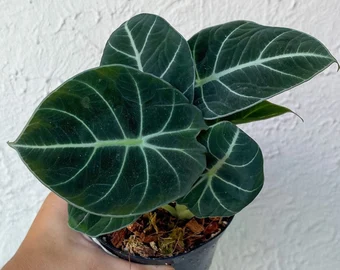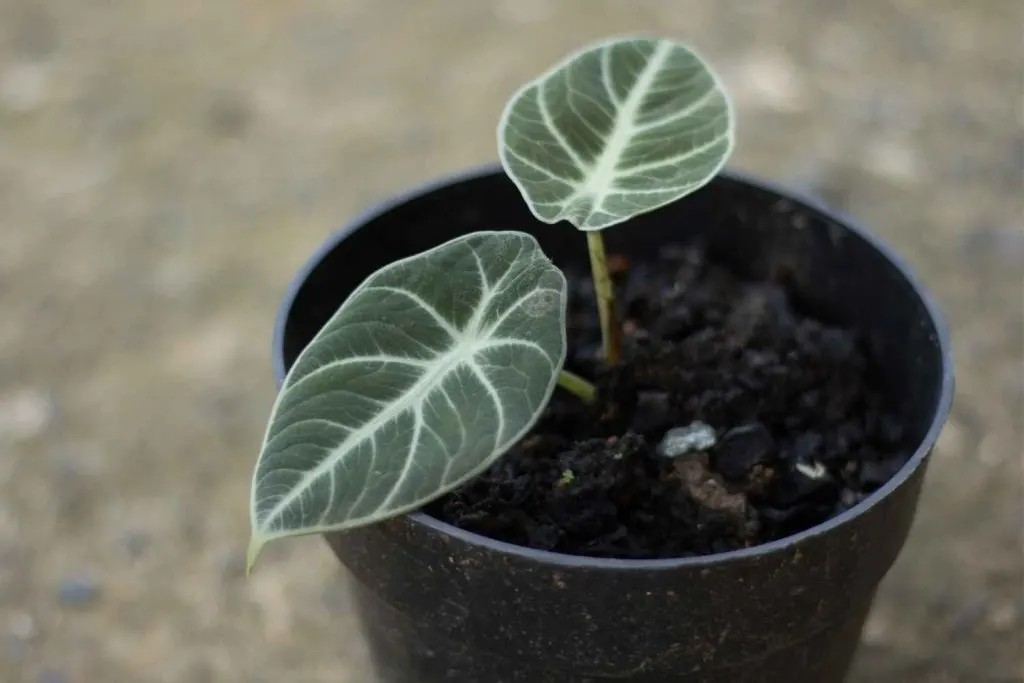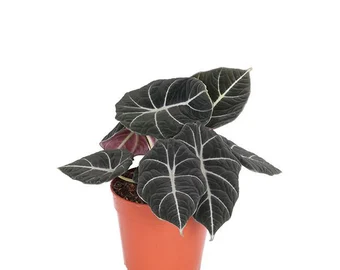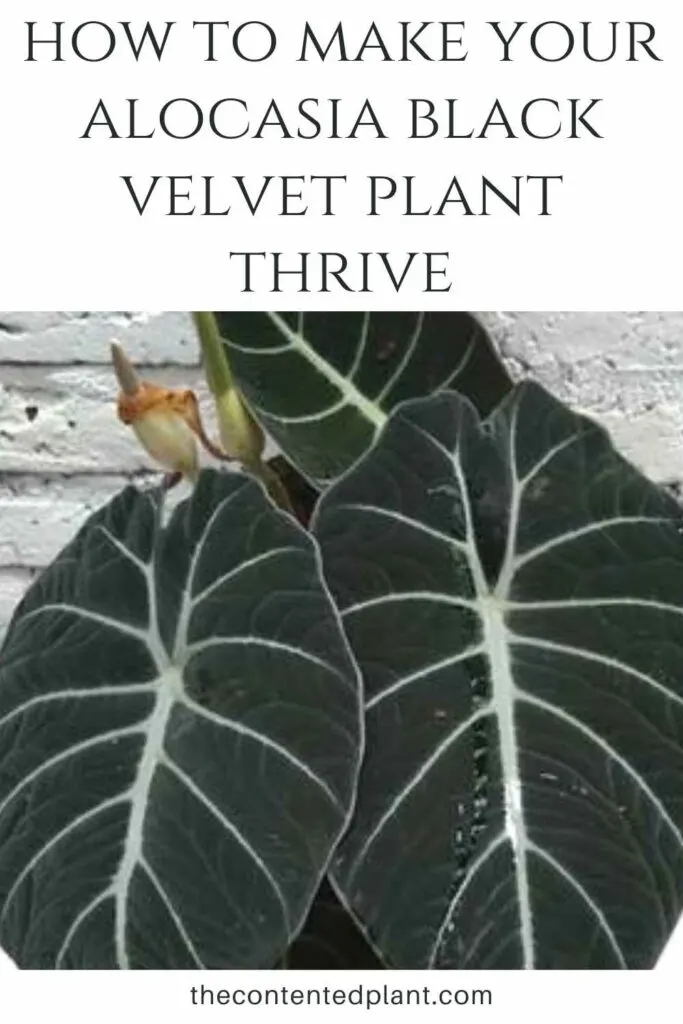Alocasia Black Velvet is one of the smaller Jewel Alocasias. The dark dramatic, velvet textured leaves have a purple underside and strong white veining.
It makes a statement on your houseplant shelf or tabletop.
They are considerably smaller than the ginormous Alocasia Elephant Ears that grow large enough to engulf a whole corner of your living room.
The Black Velvet plant(otherwise known as the little queen) will mature at about 18 inches high with a spread of only about half that.
All Alocasias are aroids in the plant family Araceae. These plants do flower and may flower all year when happy on upright spadixes. Like an anthurium or Peace Lily.
However, the alocasia Reginula black velvet flowers are small and not as beautiful as the anthuriums or peace lilies. These plants are grown for their flashy dramatic leaves. And compact upright growing habits.
This small alocasia makes a lovely small bush to adorn an area in your home that needs a bit of drama.
Shop Alocasia Black Velvet On Etsy!

Alocasias are native to southeast Asian tropical rainforests. The black velvet is said to have been first collected from the jungles of borneo in the 1800s.
So they enjoy high humidity, stagnant warm air and loose friable soils.
Like the picky Calatheas, the black velvet is tricky to keep alive. Its tender rhizomes need proper care. Or they will rot. Or not grow well and stunt the plant.
Our care guide will walk you through the care tips for this little beauty.

Alocasia Black Velvet Care:
Black Velvet care is similar to other alocasias. Like all aroids, alocasias do NOT like wet feet. Without careful attention to these plants watering needs you are courting Root Rot.
Our plant care guide will show you the proper potting soil mix for these plants. Remember, to keep your pots well sized to the root ball to avoid excess wet dirt around the roots.
These plants are slow growers so they will not need repotting for about 2 years. When you do repot choose a very well draining pot and keep the soil on the dryer side.
This is especially important during the dormant winter months.
Alocasia Black Velvet Care Guide

Alocasia black velvet plants have bold heart shaped velvety textured leaves. The dark leaf color contrasts sharply with the dramatic white viens and purple leaf underside.
This is a small alocasia susceptible to root rot. Pay particular attention to the watering needs of this plant.
Tools
Instructions
Soil Preference:
- This plant requires a light well draining soil mix. The black velvet cannot have water compact around the roots.
- A mix of potting soil, succulent soil mix and orchid soil mix (look for one with a lot of peat and finer bark mix) will keep the roots happiest.
- Two parts potting soil to two parts succulent mix to two parts orchid bark.
- A heavy soil potting mix is not recommended for this plant.
- Due to this alocasias senstivity to over watering LECA growing is recommended. See our LECA Post series here.
Pot Size and Type:
- This plant needs a pot only an inch or two above the previous pot size. Chooosing too large a pot can encourage root rot.
- Porous pots will work well for this alocasia. Terra cotta wicks away excess water from the soil. Black velvet plants will enjoy a pot that breathes and keeps their feet dry.
- Repot every second year or when roots come out the drainage holes on the pot bottom.
Lighting:
- Alocasia Black velvet requires moderate indirect light.
- Shield this plant from strong direct light in summer south and west sunny windows. The leaves will burn.
- Tip: Window sheers or blinds can offset some brief periods of high direct light.
Watering:
These small Jewel Alocasias are VERY easy to overwater.
- Try a watering schedule of every week. Water thoroughly until the water runs out of the pot.
- Watering is best done on a regular schedule so the plant is not over or under watered. Both can cause stress on the plant.
- Never let this plant get wet feet. Jewle Alocasias like the black velvet need to dry out between waterings.
- They cannot tolerate heavy compacted wet soil. If the soil is compacted the bottom of the soil can remain wet which encourages root rot and fungus gnats.
- Black Velvet Plants are aroids. They have roots which need a lot of oxygen and will tolerate drier conditions that larger alocasias.
- These plants are good candiates for growing in semihydroponics like LECA.
Humidity:
- Alocasias need humidity or 40 to 60% to be happy.
- TIPS: Set the container on a pebble tray with water under the pot or provide a humidifier to this tropical plant for best growth and happiness.
- Make sure you are not keeping your plant next to a heat or air vent. This will dramatically lower the humidity level.
- humidity also improves when you group plants together more closely.
- If the leaf tips go yellow or the leaves curl under on the edges. suspect humidity is too low.
How to Fertilize:
- Alocasias require regular fertilizing.
- Apply a good quality fertilizer (linked in materials) monthly through Spring and summer.
- Alternately you can use a slow release fertilizer at the beginning of the growing season.
- Decrease feedings by late Fall and allow the plant to rest through the winter months.
Temperature:
- Keep this plant at a low of 60 Degrees F. to upward of 85 Degrees F. It enjoys warmth and humidity.
Pests:
- Alocasias can be attacked by pests
- Stress by longterm overwatering, poor light, extreme temperatures and soil conditions are contributors to plant stress..
- Spider mites, mealy bugs, scale, thrips and whitefly are the most common houseplant pests you will see.
- Read our post on How to get rid of aphids and other pests with our homemade pesticide soap recipe or neems oil.
- To minimize the possibility of pests be sure to check all nursery plants before bringing them home.
- Quarantine all new plants until you are sure no pests live in them.
How to Propagate:
- This plant is easily propagated through rhizome division.
- Start with a healthy and mature Alocasia plant
- Divide the rhizomes when repotting the plant
- Plant new rhizome start into a pot with similar soil mix to the mother plant.
- Keep the soil moist while the new plant acclimates and matures
Toxicity:
1. This plant is considered toxic. Do not ingest any part of the plant. This plant can also cause mild skin irritation. Keep away from children and pets.
Notes
The video bleow applies to most Alocasias. For the black velvet remember they need to dry out between waterings and grow in small pots for the rhizome size to allow the roots to dry.
Related Content:
Follow Us:
Find us on YouTube, Instagram , Pinterest and TikTok! We love to Plant chat. We also comment, like and occasionally share your content to our daily stories. We’d love to see your plants. Share your joy in your houseplants. Happy Planting!
Recent Posts:


Alocasia Regal Shield - The Contented Plant
Tuesday 15th of February 2022
[…] beautiful elephant ear is a cross between the smaller dark leaved Alocasia Black Velvet and the Large leafed Alocasia […]